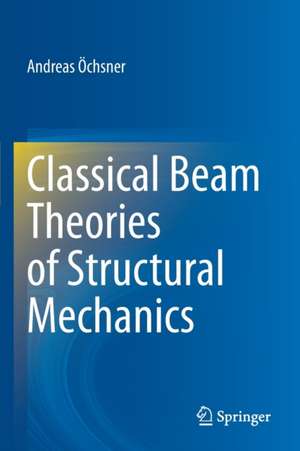Classical Beam Theories of Structural Mechanics
Autor Andreas Öchsneren Limba Engleză Paperback – 15 iun 2022
Partial differential equations lay the foundation to mathematically describe the mechanical behavior of all classical structural members known in engineering mechanics. Based on the three basic equations of continuum mechanics, i.e., the kinematics relationship, the constitutive law, and the equilibrium equation, these partial differential equations that describe the physical problem can be derived. Nevertheless, the fundamental knowledge from the first years of engineering education, i.e., higher mathematics, physics, materials science, applied mechanics, design, and programming skills, might be required to master this topic.
| Toate formatele și edițiile | Preț | Express |
|---|---|---|
| Paperback (1) | 579.34 lei 43-57 zile | |
| Springer International Publishing – 15 iun 2022 | 579.34 lei 43-57 zile | |
| Hardback (1) | 642.03 lei 43-57 zile | |
| Springer International Publishing – 14 iun 2021 | 642.03 lei 43-57 zile |
Preț: 579.34 lei
Preț vechi: 681.58 lei
-15% Nou
Puncte Express: 869
Preț estimativ în valută:
110.89€ • 120.49$ • 93.21£
110.89€ • 120.49$ • 93.21£
Carte tipărită la comandă
Livrare economică 21 aprilie-05 mai
Preluare comenzi: 021 569.72.76
Specificații
ISBN-13: 9783030760373
ISBN-10: 3030760375
Pagini: 186
Ilustrații: XIII, 186 p. 160 illus., 70 illus. in color.
Dimensiuni: 155 x 235 mm
Greutate: 0.29 kg
Ediția:1st ed. 2021
Editura: Springer International Publishing
Colecția Springer
Locul publicării:Cham, Switzerland
ISBN-10: 3030760375
Pagini: 186
Ilustrații: XIII, 186 p. 160 illus., 70 illus. in color.
Dimensiuni: 155 x 235 mm
Greutate: 0.29 kg
Ediția:1st ed. 2021
Editura: Springer International Publishing
Colecția Springer
Locul publicării:Cham, Switzerland
Cuprins
Introduction to Continuum Mechanical Modeling.- Euler-Bernoulli Beam Theory.- Timoshenko Beam Theory.- Higher-Order Beam Theories.- Comparison of the Approaches.- Outlook: Finite Element Approach.- Appendix.
Notă biografică
Andreas Öchsner is Full Professor for Lightweight Design and Structural Simulation at Esslingen University of Applied Sciences, Germany. Having obtained a Dipl.-Ing. degree in Aeronautical Engineering at the University of Stuttgart (1997), Germany, he served as a research and teaching assistant at the University of Erlangen-Nuremberg from 1997 to 2003, while working to complete his Doctor of Engineering Sciences (Dr.-Ing.) degree. From 2003 to 2006, he was an Assistant Professor at the Department of Mechanical Engineering and Head of the Cellular Metals Group affiliated with the University of Aveiro, Portugal. He spent seven years (2007–2013) as a Full Professor at the Department of Applied Mechanics, Technical University of Malaysia, where he was also Head of the Advanced Materials and Structure Lab. From 2014 to 2017, he was a Full Professor at the School of Engineering, Griffith University, Australia, and Leader of the Mechanical Engineering Program (Head ofDiscipline and Program Director).
Textul de pe ultima copertă
This book provides a systematic and thorough overview of the classical bending members based on the theory for thin beams (shear-rigid) according to Euler-Bernoulli, and the theories for thick beams (shear-flexible) according to Timoshenko and Levinson. The understanding of basic, i.e., one-dimensional structural members, is essential in applied mechanics. A systematic and thorough introduction to the theoretical concepts for one-dimensional members keeps the requirements on engineering mathematics quite low, and allows for a simpler transfer to higher-order structural members. The new approach in this textbook is that it treats single-plane bending in the x-y plane as well in the x-z plane equivalently and applies them to the case of unsymmetrical bending. The fundamental understanding of these one-dimensional members allows a simpler understanding of thin and thick plate bending members.
Partial differential equations lay the foundation to mathematically describe the mechanical behavior of all classical structural members known in engineering mechanics. Based on the three basic equations of continuum mechanics, i.e., the kinematics relationship, the constitutive law, and the equilibrium equation, these partial differential equations that describe the physical problem can be derived. Nevertheless, the fundamental knowledge from the first years of engineering education, i.e., higher mathematics, physics, materials science, applied mechanics, design, and programming skills, might be required to master this topic.
Caracteristici
Provides a systematic and thorough overview of the classical bending members Eases the mathematical complexity by applying the theoretical concepts to one-dimensional members Offers a new approach and treats single-plane bending in the x-y plane as well in the x-z plane equivalently
